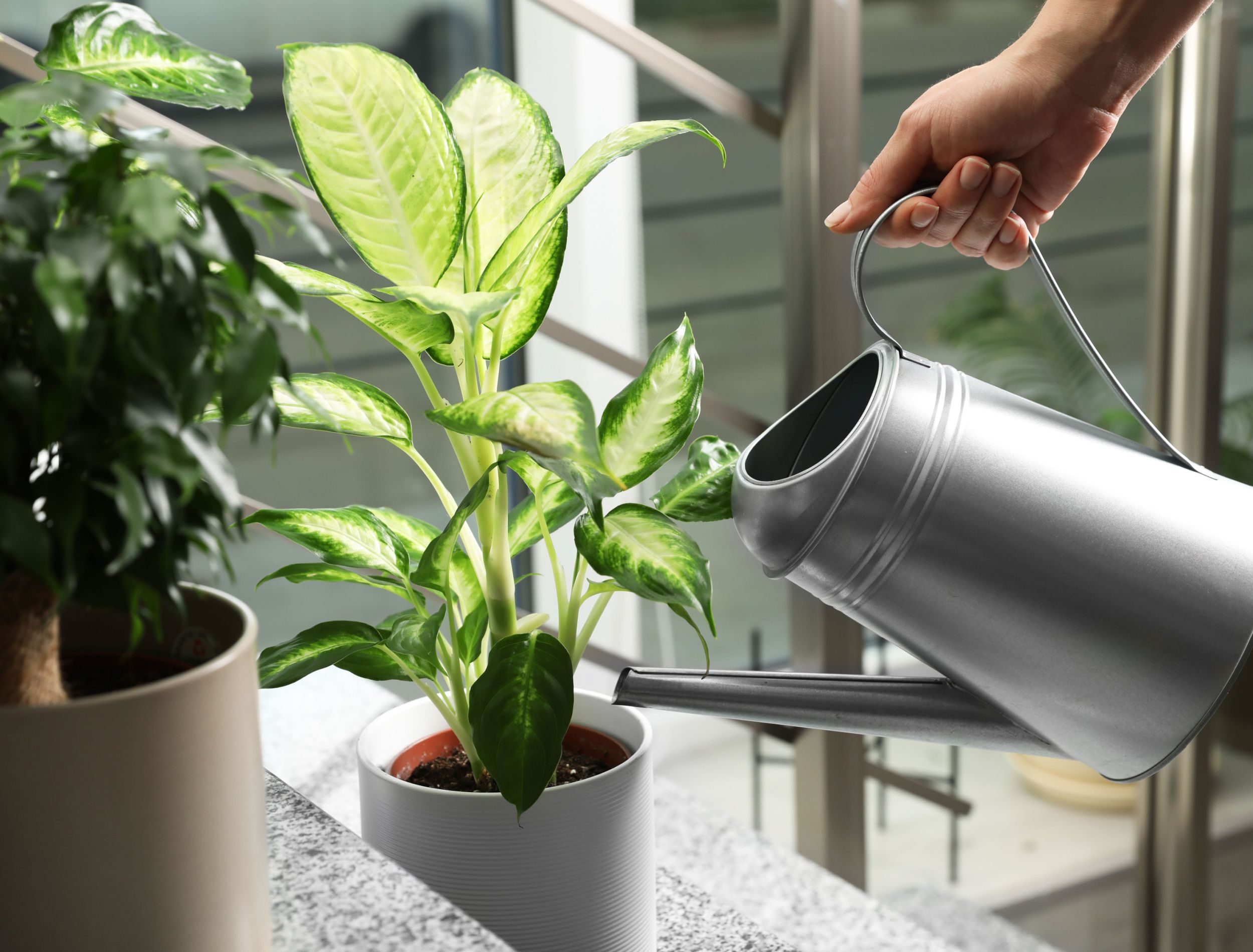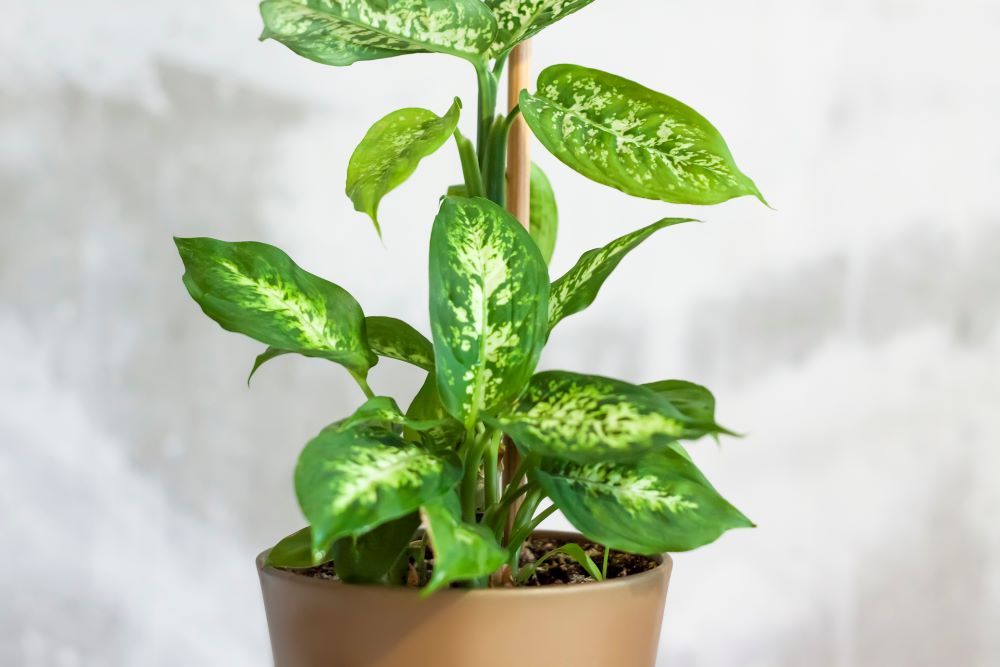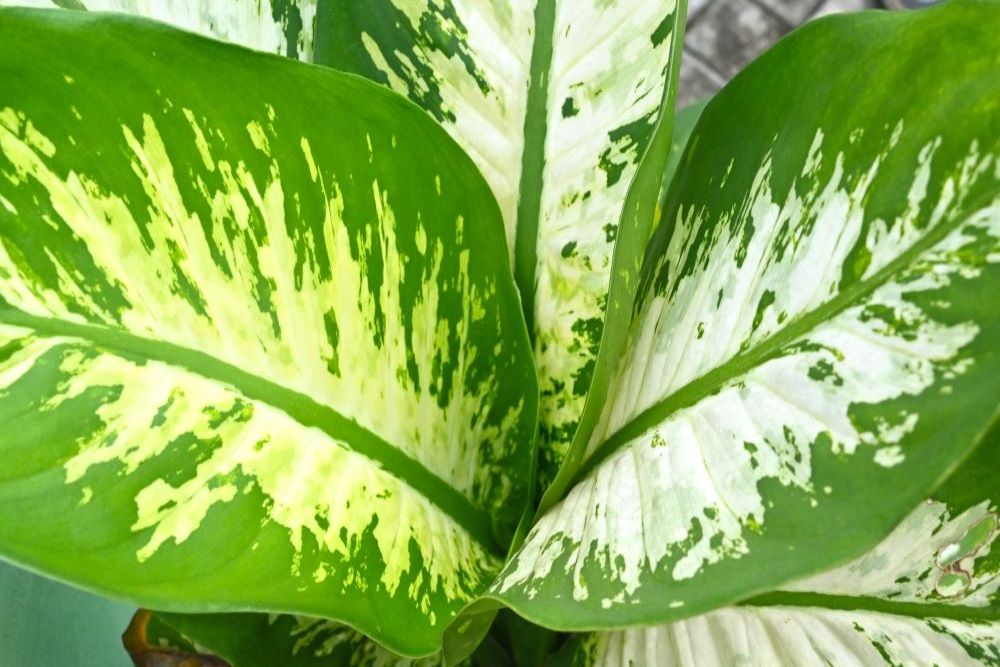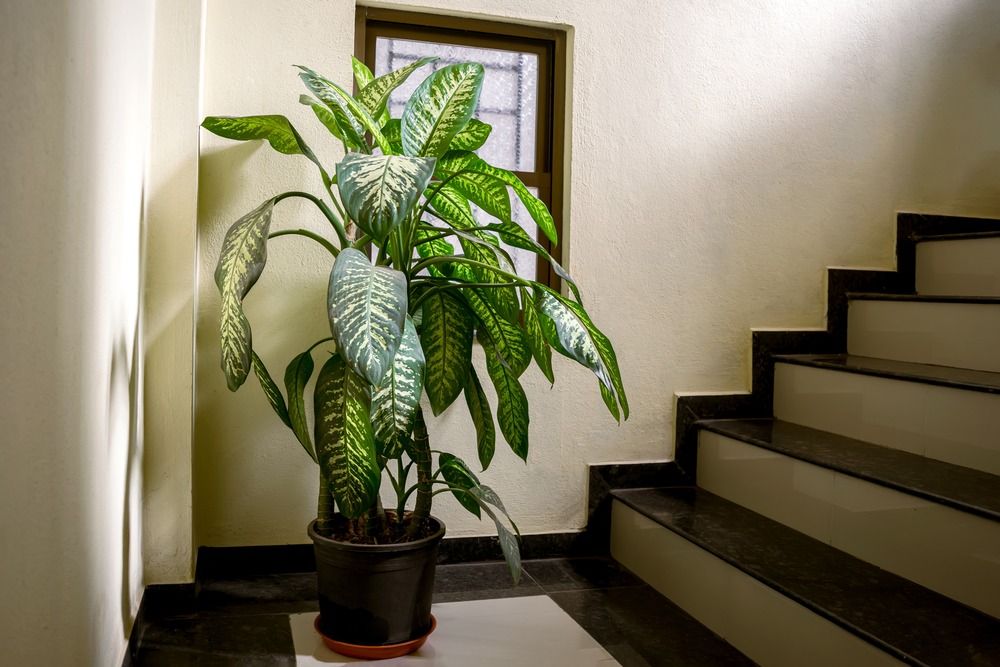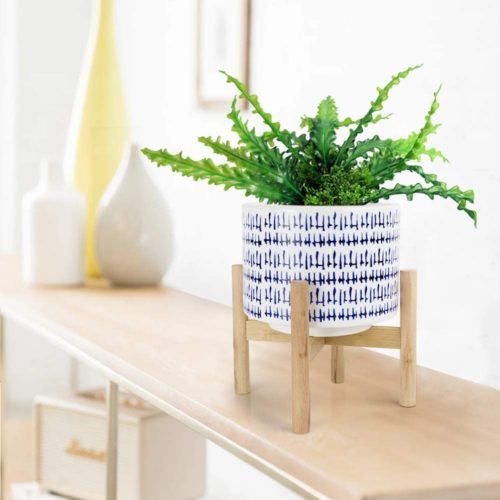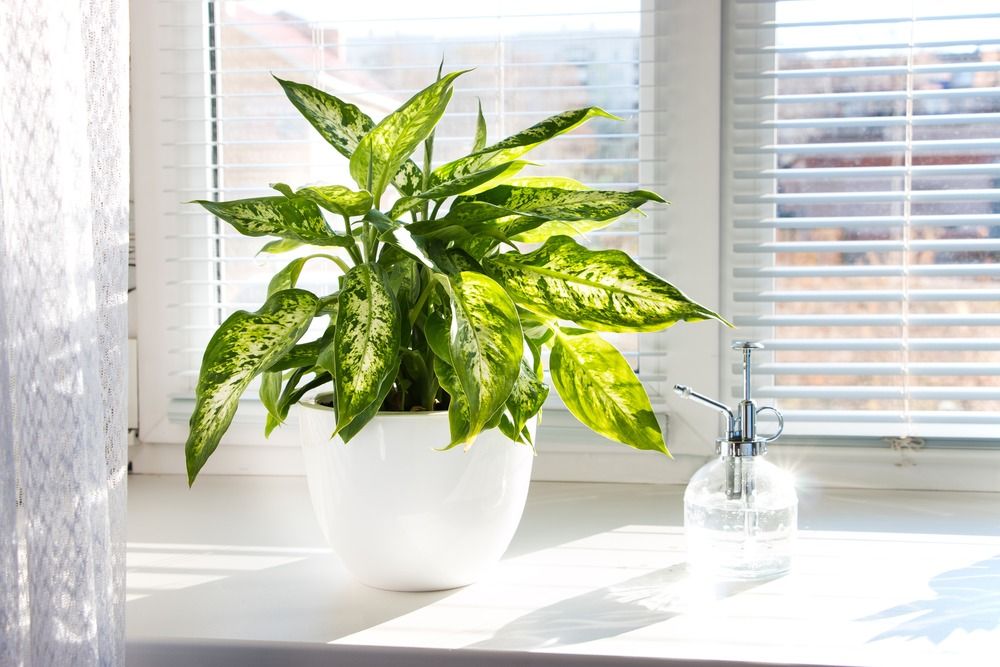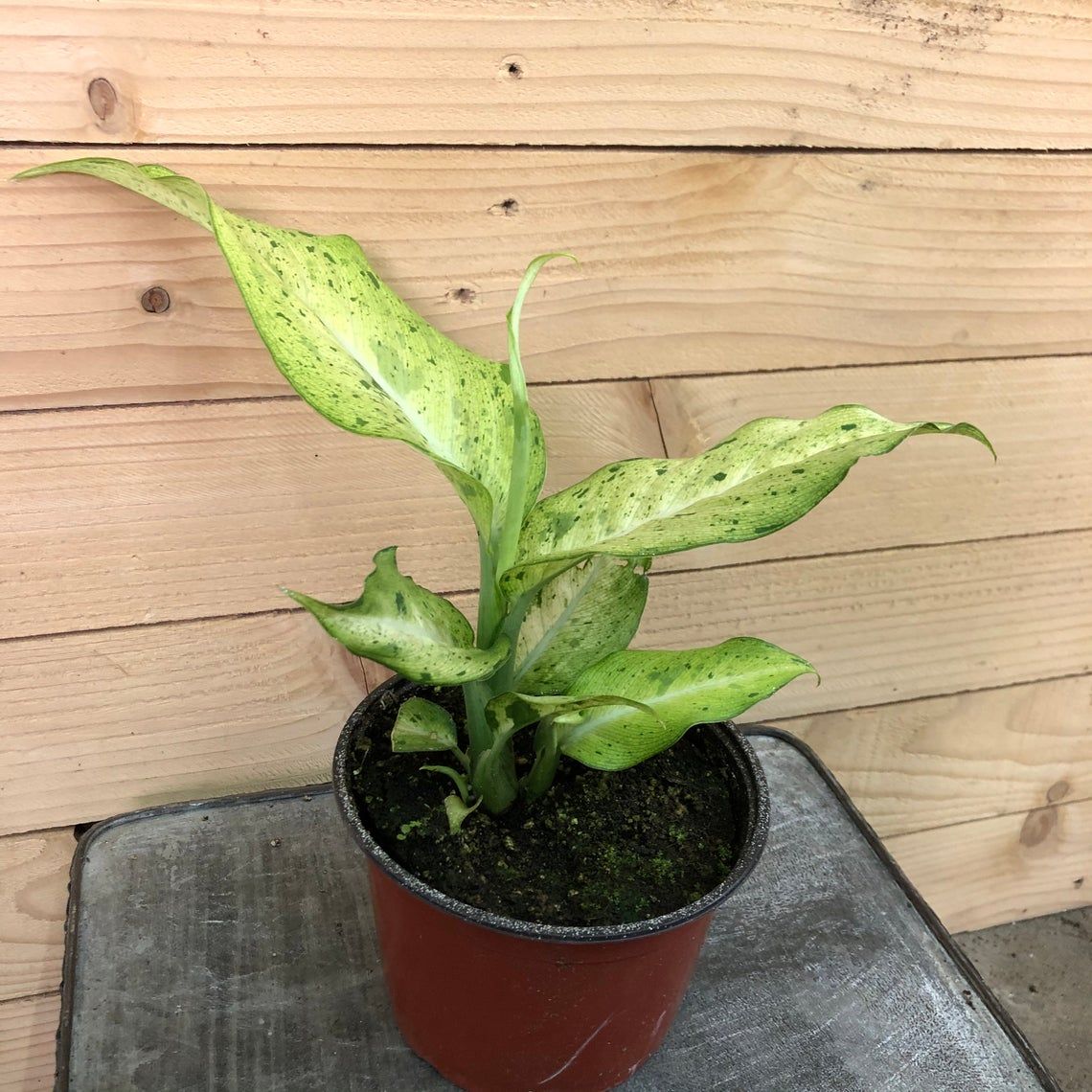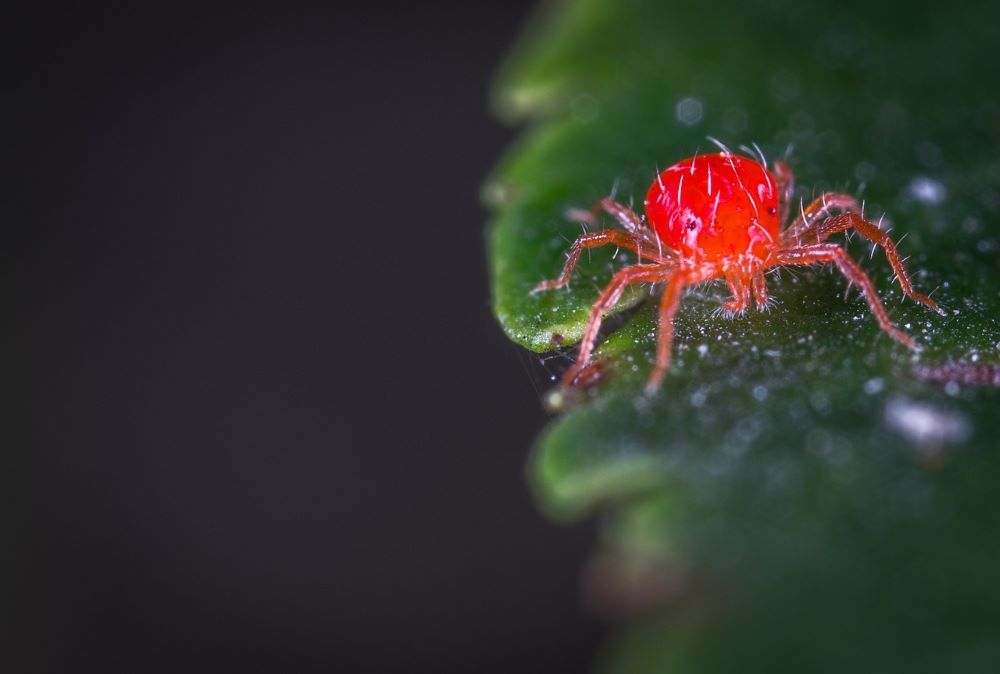With large variegated leaves that come in a variety of gorgeous patterns and colors, dumb cane plants, also known as dieffenbachias, are popular houseplants among beginners and experienced plant lovers. In ideal conditions, they're quick growers, gracing your home with leaves that can reach 18 inches long!
Discover everything you need to know regarding how to care for a dieffenbachia, including light, water, and fertilizer needs; how to propagate, divide, and prune; and some of the most popular cultivars.
Dieffenbachia Details
These tropical houseplants come from Central and South America
|
Common Names |
Dieffenbachia, dumb cane |
|
Scientific Name |
Dieffenbachia spp. |
|
Popular Cultivars |
'Camille,' 'Compacta,' 'Hilo,' 'Tiki,' and 'Tropical Snow' |
|
Native Area |
Central and South America |
|
Light |
Bright, indirect sunlight |
|
Water |
Prefers evenly moist, well-draining soil |
|
Ideal Temperature |
60 to 75 degrees Fahrenheit |
|
Humidity |
High humidity above 50% |
|
Hardiness Zones |
10 to 12 |
|
Height |
1 to 8 feet tall |
|
Pest |
Mealybugs and spider mites |
|
Disease |
Erwinia soft rot, anthracnose, and leaf spot |
|
Toxicity |
Toxic to pets and people |
Dieffenbachia Benefits
These tropical plants improve indoor air
In addition to bringing gorgeous greenery indoors, dieffenbachia is also known for its ability to improve indoor air quality.
- According to the US Environmental Protection Agency, people spend up to 90% of their time indoors, where the pollution is up to five times higher.
- Dieffenbachia is effective at filtering out common household air pollutants like formaldehyde, benzene, trichloroethylene, toluene, and ammonia.
- Thanks to dieffenbachia's large leaves, it's one of the most effective plants at absorbing carbon dioxide and releasing oxygen, improving your and your family's well-being.
Dieffenbachia Care
Dieffenbachia plant care requires knowing its origins
Dieffenbachias hail from the tropical rainforests of South and Central America. There, they thrive in a warm, humid environment and the diffuse sunlight the canopy provides.
You can ensure your dieffenbachia flourishes indoors by providing them with a similar environment. You can even grow your dieffenbachia outside if you live in hardiness zones 10 to 12.
Due to their toxic nature, always wear gloves when caring for dieffenbachias.
Give It Just the Right Amount of Water
One of the most common dumb cane growing problems is overwatering, which can lead to fungal diseases and dreaded root rot.
- Water when the top 1 inch of soil is dry. The best way to measure this is by sticking your finger in the soil or using a moisture meter.
- Make sure the pot has sufficient drainage holes and water until you see it draining out the bottom.
- How frequently you water will depend on what temperatures your plant is exposed to and how much light it's getting. In the summer, you will need to water your plants more than in the winter.
- To provide them with the humidity they need, you can place a humidifier in their room or place them on top of a tray with pebbles and water. Make sure the pot does not sit in water.
- Mist their beautiful leaves weekly.
Place It in a Space With Diffuse Sunlight
The best lighting for dumb cane plants is filtered light. Direct sunlight will burn their beautiful leaves.
- You can achieve this by putting your dieffenbachia on a window sill with a sheer curtain that filters the sun’s rays.
- Aim for about four to six hours of indirect sunlight each day.
- Generally, north and east-facing windows are ideal as they provide indirect sunlight.
- Rotate your plant weekly so that all of its sides are exposed to an adequate amount of sunlight.
- While these plants can tolerate low light situations, it will slow their growth and diminish their vibrant colors.
Some dumb cane varieties are more resilient than others, and some even prefer low light. Make sure to check your plant’s individual lighting care requirements before positioning it.
Plant in the Right Container With Fertile, Well-Draining Soil
Dieffenbachias do best in fertile, well-draining soil with good moisture retention. The container you use should have adequate drainage holes to enable this balance.
- A potting mix created with equal parts soil, vermiculite, and peat moss offers the needed draining and moisture retention.
- Large dieffenbachia plants will require pots about 12 to 16 inches in size, while more compact varieties will do better in 6 to 8-inch pots.
Ceramic Plant Pot With Wood Stand - 7.3 Inches
- If you are looking for a beautiful piece to bring in a sense of minimalistic style, look no further than this ceramic planter. The hand-painted blue ripple pattern makes every piece a work of art. Use the plant pot alone or with the chic wooden stand to showcase your favorite plants!
- Get the Price!
Dieffenbachias Love Warmth
Dumb canes thrive in temperatures ranging from 60 to 75 degrees Fahrenheit.
- If the temperature frequently dips below 55 degrees Fahrenheit, it will slow the growth of your plant.
- If temperatures reach over 85 degrees Fahrenheit, it can stunt its growth.
Provide Fertilizer for Healthy Growth
Dumb canes are considered heavy feeders.
- Apply a balanced liquid fertilizer, such as 10-10-10 (N-P-K), every four to six weeks during its active growing season in the spring and summer.
- N-P-K stands for nitrogen, phosphorus, and potassium, important nutrients for plants' growth and health.
- Make sure to water the plant before fertilizing to prevent it from burning your plant’s roots and to ensure that the fertilizer gets deep into the soil.
Triple 10 All-Purpose Liquid Fertilizer
- Triple 10 10-10-10 with Amino Acids (5.5%) & Seaweed Extract is a generic liquid fertilizer designed for all stages of plant growth. Great for gardens, flowers, fruits, vegetables, turf grasses, etc. Suitable for indoor & outdoor use.
- Get the Price!
Prune Your Dumb Cane to Preserve Its Form
For cosmetic reasons and the plant’s health, prune away dead and dying branches when they emerge.
- As dieffenbachias grow, their lower leaves can drop off, revealing thick stems. This can result in leggy plants with excessive top growth. For a bushier plant, cut the stems back right above a leaf node to the desired height.
- Use sharp, clean pruning shears.
- Cut at a 45-degree angle, and never remove more than one-third of the plant's foliage. Cutting at an angle allows water to drain out. This prevents possible disease due to moisture buildup.
When handling the plant, be very careful that none of its sap gets on your bare skin. Dumb cane's common name derives from the oxalic acid in its stems and foliage that can cause pain and swelling in the mouth. Always wear gloves and wash your hands and tools thoroughly with warm water and hand soap after any handling, just to be safe.
Propagate Your Plant Using Cuttings
Propagate your dieffenbachia plant through cuttings to enjoy more of these beautiful plants throughout your home or to share with friends.
- Before cutting, sterilize your pruning shears by dipping them in isopropyl alcohol.
- Take 2-inch cuttings from the bare canes or stem tips. Make sure each cutting has a node.
- Fill small containers with sand or sphagnum moss. Moisten them thoroughly, and let the water drain out of them for a moist, but not soggy, medium.
- Dip the end of your cuttings in rooting hormone, brushing off excess powder. Make a hole in the middle of the planting medium and then plant your cutting in it.
- Place your container in a warm spot with low light. Keep the soil moist by regularly spraying it with water.
- It will take four to eight weeks for roots to develop. When they do, you can plant your dieffenbachia in a bigger container and place in bright, indirect sunlight. Enjoy your new plant!
The Most Popular Dieffenbachia Varieties
Choose a cultivar ideal for your home's environment
Dieffenbachia plants come in numerous colors with various leaf patterns. Explore some of the most popular cultivars.
'Camille'
This cultivar has broad leaves edged in emerald green with pale yellowish-green centers.
- It’s a smaller variety, growing to about 3 feet tall, making it great for compact spaces.
- If you grow this plant in low-light conditions, it will lose some of its variance, turning more of a solid green color.
'Camouflage'
The eye-catching speckled pattern on this variety gives it an unusual look that sets it apart from other dieffenbachia plants.
- It has long, wide leaves that are light green with dark green and cream spots.
- This cultivar can grow to about 4 feet tall.
'Camouflage' Plant (6-Inch Growers Pot)
'Tropic Snow'
This elegant dumb cane variety has an absolutely gorgeous emerald and cream pattern on its leaves.
- Its foliage is large and glossy.
- It brings stunning tropical aesthetics to your home, growing up to 6 feet tall.
'Tropic Marianne'
Topic Marianne has huge, wide leaves that can grow to be 12 inches wide. The leaves have emerald around their edges, which looks incredible in contrast with their yellowish-cream centers.
- It’s one of the most popular varieties and is widely regarded as one of the more resilient.
- Grows up to 4 feet.
Common Dieffenbachia Growing Questions
There are a few pests and diseases to watch out for
Discover the answers to the most common dieffenbachia growing questions.
What is the Growth Rate of Dieffenbachia Plants?
How fast your dieffenbachia plant grows typically depends on the variety and growing conditions.
- Some compact dieffenbachia varieties are slower growers, ultimately reaching between 2 and 4 feet tall.
- Other dumb canes may reach up to 8 feet.
- Their widths also range widely, spanning anywhere from 1 to 5 feet.
- If it's grown in less than-ideal conditions, like in low light or without fertilizer, you may see a slower growth rate.
What are Common Dieffenbachia Pests and Diseases?
Dieffenbachia plants may be susceptible to spider mites and mealybugs.
- Mealybugs look like very small cotton bundles that cling to your plant. To combat them, you can first try peeling them off with cotton swabs dipped in rubbing alcohol. If that doesn’t work, consider using an insecticidal spray.
- Spider mites are almost invisible. However, if your plant’s leaves become bleached and have a web-like substance on their underside, then you probably have a spider mite problem. To fight them, apply a miticide to your plant. You will have to repeat the application every couple of weeks until they are gone as they often embed their eggs in the soil.
Dieffenbachia can also be attacked by bacteria called Erwinia and may struggle with anthracnose, a fungal disease.
- Erwinia normally shows up in leaf joints or stems, causing them to rot. If your plant has Erwinia, it’s too late to save it.
- Anthracnose typically develops if the plant is exposed to too much humidity or a sudden chill. To beat it, remove leaves with black and dark brown spots that have been infected.
Are Dieffenbachia Plants Toxic?
Yes, dieffenbachia plants are toxic to humans and pets.
- When eaten, dumb cane can cause swelling in the tongue and throat, the production of an excessive amount of saliva, and temporary loss of speech. If enough is eaten, it can even cause suffocation.
- If the sap comes into contact with your skin, it can cause irritation and burning.
- Do not place your plant anywhere that a child or pet could access it and eat it. Even though this is an awesome plant, because of its toxicity, it might not be a great plant for people with pets.
This large, showy houseplant is an incredible addition to interior spaces, brightening up rooms, purifying the air, and looking fabulous. With the right dieffenbachia care, including lighting, climate, and water, you can enjoy this incredible tropical plant long into the future!

